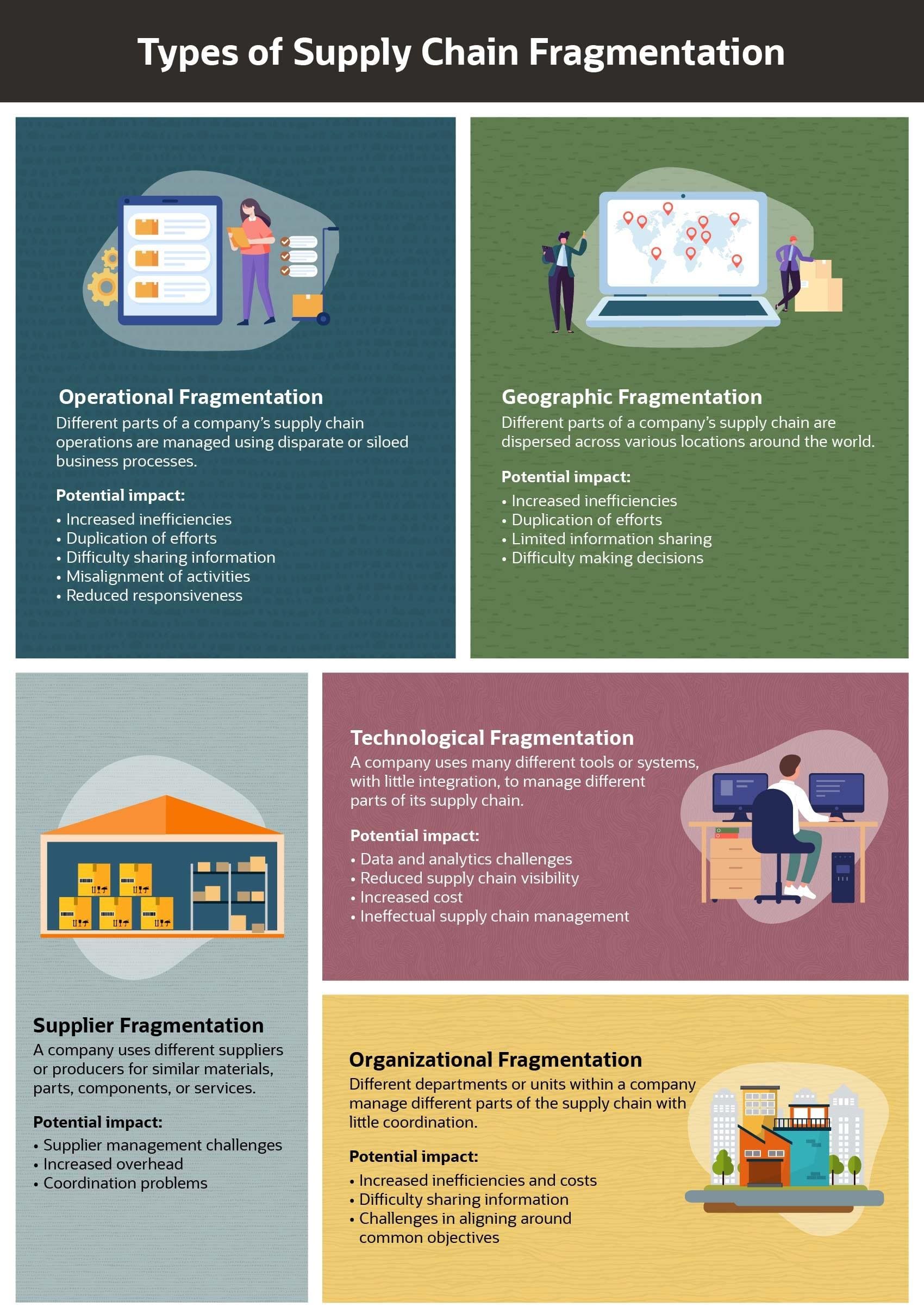Today’s supply chains are more complex and fragmented than ever. That is, many products are made piece by piece via a global assembly line that stretches nearly all the way around the planet. In many cases, several companies, often located in different countries, are involved in each step of the supply chain process, from the initial sourcing and processing of raw materials to the delivery of the final product to the customer.
Although the framework of today’s supply chains offers companies many benefits, such as lower prices and access to specialized materials, capabilities and skills, a fragmented supply chain poses risks, especially when the supply chain process is poorly managed. Understanding the basics of supply chain fragmentation and learning the best practices for taming its complexity, while improving integration and collaboration, are essential to establishing reliable and resilient sources of supplies.
What Is Supply Chain Fragmentation?
Supply chain fragmentation occurs when a company uses a variety of suppliers and manufacturers to produce and distribute its goods and services because of specialized, geographical, or risk mitigation purposes. For instance, a company may decide to source some of its raw materials in one country and some in another; it may enlist manufacturers in a third country to produce the goods; and it might sell completed products in a fourth country.
Supply chain fragmentation occurs in varying degrees and forms. Geographic and supplier fragmentation — i.e., farming out aspects of production to different countries or companies — is the most visible type of fragmentation that occurs. Yet the supply chain can be divided into parts in other ways, as exemplified by technological fragmentation, organizational fragmentation and operational fragmentation.
Several years ago, limitations in transportation and technology meant that most products had to be manufactured relatively close to the source of needed raw materials, as well as to prospective customers. In many cases, a single company would retain control of the end-to-end process of manufacturing and delivering its products. In recent decades, however, more companies are taking advantage of a combination of technology advances, globalization and trade agreements to break down the production of their goods into more discrete parts that can be managed by a variety of partners, including those located at great distances.
The cellphone in everyone’s pocket, for example, is made up of hundreds of components that may be sourced, produced and assembled by different companies in a wide variety of locations. In fact, it has become the norm for most production to be significantly segmented, with each link in the supply chain run by a separate company that may further distill its own approach to production into individual segments that are carried out by various other companies.
Key Takeaways
- Supply chain fragmentation occurs when a company works with several suppliers and manufacturers to produce a product and bring it to market.
- Fragmentation can take various forms, including geographical, organizational, operational and technological.
- Supply chain fragmentation has increased due to a number of factors, including globalization and outsourcing, technological advancements, and political and economic dynamics.
- Companies can manage supply chain fragmentation and increase integration through better data sharing, advanced supply chain management technology and greater collaboration.
Supply Chain Fragmentation Defined
A supply chain is composed of a network of several businesses, all playing a role in creating and selling a product or service. A multitude of links are included in the supply chain, starting with the earliest sourcing of raw materials and moving on to the production of all the components needed to complete the assembly of those parts, product testing, distribution to sellers and delivery to customers.
Supply chain fragmentation can occur when the sequence of steps in the process is broken down into distinct segments, each carried out by different partners in various geographic locations, often using distinct technologies and employing siloed processes. But it is not the segmentation itself that causes potentially problematic fragmentation in the supply chain. Rather, it is the failure to effectively integrate and create visibility across those discrete segments that often creates trouble for companies.
Indeed, fragmentation is one of the greatest sources of friction in supply chains today. The supply chain disruptions that occurred during the COVID-19 pandemic were largely the result of a lack of visibility and control in highly fragmented supply chains.
Causes of Supply Chain Fragmentation
In the past, supply chains were relatively straightforward, limited to perhaps a few companies and largely contained within a specific geographic region. In contrast, today’s supply chains are exceedingly complex and often dispersed — in some cases, involving hundreds of companies in a number of countries. To get an idea of just how segmented today’s supply chain has become, so-called intermediate goods, which are products used to produce another finished product, make up half of all trade in global product supply chains, according to the World Trade Organization(opens in a new tab).
Several factors are causing greater fragmentation in supply chains. In some cases, fragmentation occurs due to internal inconsistencies(opens in a new tab) in the way companies manage various aspects of their supply chains. In other cases, supply chain fragmentation results from the pursuit of new opportunities to cut costs, improve the quality of products or expand production. Here are some of the primary drivers of fragmented supply chains.
Globalization and Outsourcing
In the 1970s, companies began to outsource certain processes to third parties that could perform tasks faster, better and cheaper. Some U.S. manufacturers shifted production to factories in Mexico, for example. Over time, these efforts drastically increased the complexity and fragmentation of supply chains. Fragmentation was further fueled by a growth in globalization, as companies began to look beyond their own geographic borders to conduct business. Many companies found that they could source materials more cheaply, or access larger, lower-cost labor forces, by forging ties with overseas suppliers and manufacturers. A combination of globalization and outsourcing helped usher in a new era of longer, more dispersed supply chains.
Technological Advancements
The increased availability of better technology, often at less cost, has allowed companies to manage a larger number of suppliers and partners, including many that are geographically dispersed. This, in turn, has made it easier for companies to further break down aspects of production to farm tasks out to companies in other locations. Advanced technological tools and systems have transformed the process of sourcing, shipping and tracking goods as products travel from one place to the next, which has allowed companies to more effectively manage an increasingly complex and segmented supply network.
Competition and Cost-Cutting Measures
As the marketplace has grown more global and many products have become more commoditized, more pressure has been placed on companies to lower the prices of their goods and services. This has compelled companies to segment their supply chains in ways that enable them to produce their products more cheaply, quicker or with higher quality either by working with external suppliers and producers or by setting up their own production facilities in different locations.
Political and Economic Factors
Free-trade agreements have provided companies with duty-free access to labor and materials abroad. The United States-Mexico-Canada Agreement, for example, encourages mutually beneficial trade among the three countries. Some countries or geographic regions may offer companies tax-free holidays or other incentives to set up production facilities in their jurisdictions. Conversely, in some areas, strict government regulations may push companies to move aspects of their production to parts of the world where there are fewer restrictions. Economic factors can come into play, as well. A slowing economy or other market shifts and disruptions may compel companies to cut costs in their supply chains, which may increase fragmentation. Or, a shortage of skills or labor in a particular country might prompt a company to send more aspects of its production to other areas.
Types of Supply Chain Fragmentation
Supply chain fragmentation can take several different forms. In some cases, fragmentation results when a company’s supply chain is managed by different internal departments or uses varied tools and processes with minimal coordination. In other cases, fragmentation occurs in the larger supplier ecosystem, when various segments of the supply chain are managed by discrete suppliers in various geographies. The most common types of fragmentation are:
Operational Fragmentation
When different parts of a company’s supply chain operations are handled by unconnected business processes with little coordination or integration, the supply chain may suffer from operational fragmentation. This can lead to inefficiencies, duplication of efforts, difficulties in sharing information, misalignment of activities and reduced responsiveness.
Geographic Fragmentation
Geographic fragmentation occurs when a company’s supply chain is dispersed across widespread parts of the world. This can happen in companies working with separate entities in another country, or it may involve a company setting up its own production facilities abroad. Geographic fragmentation within the supply chain can result in longer lead times, increased transportation costs and difficulty coordinating with partners across time zones.
Supplier Fragmentation
When a company relies on multiple suppliers or producers to provide its materials, parts, components or services, the company may experience supplier fragmentation. Sometimes, supplier fragmentation may be warranted, since redundancy in ordering supplies can help mitigate the risk of disruptions that will slow the availability of products. However, supplier fragmentation can also create challenges in supplier relationship management — plus, it can increase overhead, cause order and delivery coordination problems and create product quality issues.
Technological Fragmentation
Technological fragmentation may occur when a company uses isolated tools and unintegrated systems to manage different parts of its supply chain. This lack of a centralized technology solution, such as an enterprise resource planning (ERP) system, can create significant challenges in sharing and analyzing data within a company or across a supply chain. This, in turn, can result in a host of problems, including lack of visibility, ineffectual supply chain management or logistics, poor decision-making and increased costs. Technological fragmentation can also result from companies grappling with different technology standards among countries. Such technological fragmentation alone could result in gross domestic product losses of 5% for many countries, according to the International Monetary Fund. In addition, it could hamper innovation efforts and productivity levels within the global supply chain.
Organizational Fragmentation
A company’s supply chain may experience organizational fragmentation when various aspects of its production are managed independently by different departments or businesses, with little coordination. Such organizational fragmentation can give rise to challenges in coordinating activities, sharing information and aligning teams around common objectives.

Impacts of Supply Chain Fragmentation
The cascade of supply chain disruptions that began during the lockdowns in the early days of the COVID-19 pandemic demonstrate the devastating impact that supply chain fragmentation can wreak. Few industries escaped the pandemic unscathed, as most suffered from the risks inherent in long and fragmented — yet immensely interdependent — supply chains, especially those lacking end-to-end visibility. The unavailability of a small, yet vital component produced halfway around the world was enough to halt entire production lines. One weak link in the chain had wide-reaching network effects.
While the repercussions of supply chain fragmentation are not always so widespread and dramatic, they can be significant nonetheless. Some of the most common impacts include:
Increased Costs and Reduced Efficiency
Supply chain efficiency — that is, how effectively a company gets its products to the right place at the right time and at the lowest possible cost — is the key to success for manufacturers. Many companies source materials, components and goods from low-cost, highly efficient overseas providers to save money and increase productivity. Yet, the resulting fragmentation can extract other costs and introduce inefficiencies. Geographic fragmentation, for example, may result in increased transportation costs and cross-border compliance issues. When a company experiences operational and organizational fragmentation, workflows may become bogged down by complex, inefficient and costly handoffs among teams. With supplier fragmentation, a company may see increased coordination costs.
Quality Control Issues
Fragmentation of any type can result in reduced product quality, due to lack of control, visibility and oversight. Geographic fragmentation can impact quality, since regulations and standards vary around the world in terms of labor and materials requirements. With supplier fragmentation, it can be hard to manage multiple providers and ensure the high quality of a wide variety of products.
Lengthened Lead Times and Delays
When companies need to coordinate the movement of goods across time zones, suppliers, functions and departments, the process can naturally take a long time and encounter bottlenecks. And anytime there is any kind of disruption within the supply chain, ensuing interruptions can have a large impact. Lengthy lead times and delays pose a significant threat to the manufacturing industry, where downtime becomes a major detriment to business performance.
Reduced Transparency and Increased Risk
Fragmentation can impede the flow of information through a supply chain, thereby creating uncertainty and unpredictability. Reduced transparency may result from a lack of integration among technology systems, internal functions and business processes. During the supply chain disruptions of the pandemic, it became clear that, while some companies had visibility into the performance of their immediate tier-one providers, the further downstream companies went, the murkier their view of supply chain functions became. This lack of transparency can introduce a great degree of risk, since companies have little ability to anticipate or react to issues within their supply networks. It also makes it difficult for companies to perform essential supply chain management tasks, such as supply chain planning.
Negative Environmental Impact
A company’s supply chain has a significant impact on the environment. In recent years, companies have faced increasing pressure to demonstrate better environmental stewardship, sustainability and social responsibility within their supply chains. Yet, a supply chain with fragmentation issues could cause problems related to the pursuit of corporate environmental, sustainability and governance (ESG) goals. For example, the additional transportation required within a geographically fragmented supply chain may have a direct impact on a company’s environmental footprint. The lack of visibility and coordination that results from fragmentation also makes it difficult for companies to measure their progress against ESG goals.
How to Manage Fragmented Supply Chains
Uncontrolled supply chain fragmentation can have negative effects — on individual companies, supply networks, industries and even economies. The greater the fragmentation, the more magnified the impact may become.
However, as part of a thorough supply chain audit, best practices for managing supply chains can minimize the risks of fragmentation. The overarching goals, as with most supply chain management efforts, are increased integration and better coordination. Some actions companies can take to address supply chain fragmentation include:
Diversification and Redundancy
A single weak link in the supply chain can have a devastating impact. Since a disruption is not always predictable, companies can reduce their risk exposure by introducing redundancy and diversification into their sources of goods through creation of additional partnerships with suppliers. According to the International Monetary Fund, supply chain diversification can significantly reduce the economic impact of a labor supply contraction.
Although this effort may result in even more fragmentation, such backup strategies nonetheless can increase overall supply chain resilience. In order to be effective, however, companies must make sure they have the ability to switch from one supplier to another, when required.
Collaboration and Partnerships
The more fragmented a supply chain is, the more difficult it is for any individual player in the network to fully mitigate the systemic risk inherent in its operations. A single company may adopt its own risk-mitigating measures, like supplier diversification, operational integration and improved inventory management. Yet, its risk exposure is still reliant on the actions (or inactions) of others in its supply network. Stronger partnerships and closer collaboration among companies in the supply network is crucial. Likewise, in order to better manage internal sources of supply chain fragmentation, including operational and organizational fragmentation, companies should engage in greater internal collaboration.
These efforts to improve coordination should extend across the spectrum of supply chain management functions, such as purchasing, forecasting, inventory management, capacity planning and quality management. The goal is to optimize the flow of materials and goods across the supply chain, however fragmented, in order to meet demand.
Increased Transparency and Data Sharing
One of the most efficient ways to overcome the challenges of supply chain fragmentation is through better data management, data sharing and supply chain visibility. Indeed, effective collaboration and partnerships depend on visibility across internal and external supply chain partners and processes.
A 2021 McKinsey(opens in a new tab) study found that, while 48% of companies had visibility into what was going on with their direct tier-one suppliers, only 21% could see what was happening at their tier-two suppliers and just 2% had visibility into their tier-three suppliers. This lack of transparency can contribute to increased supply chain risk. To remedy this situation, companies should work to eliminate organizational and data silos within their own organization, as well as adopt systems for data sharing and analysis with third parties in their supply chains. Increased transparency across the supply network, from end to end, can enable earlier identification of issues, faster resolution of problems and more timely awareness of opportunities for supply chain optimization.
Technological Solutions
More than 80% of companies across sectors say they plan to increase their investment in digital supply chain technologies, according to a 2022 McKinsey(opens in a new tab) survey. In addition, a 2022 Gartner survey(opens in a new tab) found that 61% of supply chain leaders say that such technology is a source of competitive advantage for their companies. When it comes to managing supply chain fragmentation, technology solutions play a leading role. In fact, they create the foundation for greater collaboration and increased visibility.
Companies can adopt cloud-based digital supply chain management systems and integrated business planning tools to remain closely connected to their network of suppliers. Having the right technologies in place opens the door to data sharing, advanced analytics and the ability to pursue risk-mitigating efforts, such as supplier diversification. These technology solutions facilitate closer integration internally among previously siloed functions, like sales and operations planning, demand forecasting and inventory planning, as well as externally with a wide variety of supply chain partners. With access to real-time data and predictive analytics, companies can build more accurate demand forecasts, perform better supply chain planning and optimize inventory. Advanced capabilities, like artificial intelligence, machine learning and the Internet of Things, are bound to create even more opportunities to overcome issues of supply chain fragmentation.
Manage and Optimize Your Global Supply Chain

Government Interventions and Regulations
Companies aren’t the only organizations concerned with managing the impact of supply chain fragmentation. Extensive supply chain disruptions in recent years have given rise to increased governmental interest in addressing fragmentation in supply networks. Many countries are rethinking their influence on global supply chains. The possibility of another pandemic is not the only potential supply chain threat in the future. Economic volatility, geopolitical conflict and climate change can all compound the effects of supply chain fragmentation. At the same time, conflicting technology standards, trade tensions and cybersecurity concerns may pressure companies to retreat from greater integration.
Some countries are pursuing interventions to support risk mitigation tactics, such as calling for greater diversification of supplies and encouraging companies to hold more safety stock in their inventory. Government efforts to improve security and support for global supply chains can help preserve the benefits of more tightly integrated supply chains. Determining how and where to intervene, however, has proven challenging, since governments balance their desire to prevent supply chain disruption with preserving the benefits of collaboration, cooperation and economic growth.
Supply Chain Fragmentation Examples
Supply chain fragmentation exists in many sectors. It is particularly common in a number of industries, including the automobile, food and beverage, electronics and apparel sectors. Here is a look at supply chain fragmentation in each of these industries.
Automotive Industry
Automotive production represents one of the most fragmented supply chains globally. An individual vehicle may have thousands of individual components, and each of those parts must be produced and assembled from raw materials. While a major automaker, referred to as an original equipment manufacturer, is the last link in the supply chain before a car or truck goes to the dealer or is delivered directly to the buyer, automotive suppliers play starring roles in this supply chain.
Automotive suppliers are broken down into tiers. Tier-one suppliers make the purpose-built parts and components for direct assembly by manufacturers into their vehicles. While some of these companies make auto parts exclusively, others — like semiconductor manufacturers — serve multiple industries. Tier-two suppliers make parts and components for the tier-one companies. And a step downstream are the tier-three suppliers: producers of the unfinished or raw materials, like metals or plastics, that are required by tier-two suppliers.
The pandemic made it apparent that a problem at one tier can halt the entire vehicle manufacturing process. Because of the extreme fragmentation in the industry, automobile manufacturers were some of the hardest hit during this time, leading to major declines in production, sales and international trade between 2020 and 2021. Lack of components, combined with fewer available transportation options, exacerbated the COVID-19 disruption. A recent study found that companies in the automotive supply chain that design products using widely available and substitutable parts can cut disruption-associated losses by as much as 80%. Better data sharing, analytics and visibility across the automotive supply chain can also improve supply chain management and resiliency.
Food and Beverage Industry
While the global food industry may not involve as many discrete, high-tech parts as the automotive industry, the food and beverage supply chain is nevertheless very complex and fragmented. The network of food suppliers has expanded globally in recent decades to meet consumer demands for a growing array of options year-round, and the additional players in the game have led to increased geographic fragmentation. In addition, companies involved in the food supply chain are not always sharing key information, which has had a negative impact on the market, leading to difficulties in managing costs, increased instances of fraud, growing food safety issues and challenges in responding to consumer demands for greater transparency about food sourcing.
Digital supply chain technologies can enable greater data sharing, advanced analytics and increased traceability of food and beverage products. The adoption of digital tools may not only strengthen the industry’s fragmented supply chain, but also lower costs, decrease waste, strengthen brand integrity and increase customer loyalty. The World Economic Forum has called for a smart field-to-fork network with increased visibility into all points along the food supply chain to make the system more resilient, integrated, safe and sustainable.
Electronics Industry
The electronics industry is bigger than ever, with electronics integrated into a broad array of goods from televisions and toothbrushes to refrigerators and cellphones. Electronic products are empowered by circuits, circuit boards and semiconductors, each containing hundreds or even thousands of tiny hardware components.
The electronics supply chain involves a complex web of companies that design, manufacture, test, package and distribute raw materials, parts and finished products. Concurrent supply and demand shocks that hit the electronics industry during the COVID-19 pandemic revealed just how fragile the electronics supply chain could be. The fragmented network of supply suffered reduced capacity, raw material shortages, sudden increases in demand and transportation logjams. Two years of shortages, delays and rising costs gave way to ongoing uncertainty, and many companies continue to deal with constrained sources of supply and long lead times on orders.
Electronics makers and suppliers can take advantage of opportunities to better manage their fragmented supply chains on a number of fronts. First, companies can move away from lean, just-in-time production approaches and work to stock excess inventory. Then, improving information-sharing and collaboration among supply chain partners can improve alignment of inventory capacity with demand. Plus, some companies are also shifting their sources of supplies closer to their customers to curb lead times and reduce transportation costs. Finally, increased automation on production lines can yield additional benefits.
Fashion Industry
The fashion industry is another highly fragmented sector, consisting of a wide variety of apparel, footwear and accessory companies that are scattered widely around the globe. As one fashion and apparel professor at the University of Delaware has explained(opens in a new tab), a shirt labeled “made in Vietnam” may contain cotton grown in the U.S., yarn spun in Japan, fabrics woven in China and dyes obtained from Taiwan.
A fashion brand typically sources products from more than 20 countries, using hundreds of suppliers and vendors in the process. In the best of circumstances, this approach can allow apparel makers to source high-quality, cost-competitive products to keep up with changing customer tastes. But effective management of a long, fragmented and interconnected supply chain can be difficult, particularly during periods of disruption that cause significant overseas transportation issues, long lead times and increased customs costs. In an industry that, according to some estimates, accounts for as much as 10% of global carbon emissions, fragmentation can exacerbate its environmental toll and make it harder to trace and manage a company’s environmental impact. Advanced supply chain processes and technologies can help apparel manufacturers and retailers do more to manage fragmentation, as can diversifying and nearshoring their sources of materials.
Manage Your Supply Chain In One Place With NetSuite SCM
In many instances of supply chain fragmentation, data is shared through inefficient spreadsheets and email threads, with key information often trailing behind the flow of products in the physical supply chain. While manufacturers have invested in production methodologies and tools to smooth the flow of products through their supply chains, many companies also need to work on easing the flow of crucial data with the goal of more accurately aligning supply with demand.
That’s where modern supply chain management practices and technologies can help. Advanced technology, like NetSuite’s Supply Chain Management (SCM) solutions, can coordinate supply networks beyond company boundaries, enabling collaboration both internally and externally among companies and their partners and providing visibility across the entire flow of goods, from parts suppliers and manufacturers to distributors. Maintaining supply chain information with NetSuite ERP also ensures that procurement, supply chain planning and production systems are all using the same real-time data. This allows companies to more easily address challenges of supply chain fragmentation.
In addition, SCM helps companies, like apparel maker pact, avoid stockouts by maximizing product availability, based on anticipated demand; consider lead times and preassemblies to determine what materials need to arrive to prevent production delays; inspect raw materials on arrival; and conduct regular quality reviews during production to ensure that high standards are maintained. NetSuite’s software also offers predictive analytics to help companies identify potential risks and plan for how to respond to issues in their supply chain networks.
Supply chain fragmentation is increasing as a result of the combination of globalization and outsourcing, technological advancements, cost and competitive pressures and a host of political and economic factors. With the right data and technology, however, the negative repercussions of fragmented supply chains can be properly managed. Companies can take several steps to better manage supply chain fragmentation by, for example, increasing integration, ramping up data sharing and improving coordination, ensuring that they can rely on more resilient supply chains in the future.
#1 Cloud ERP
Software
Supply Chain Fragmentation FAQs
How can companies manage supply chain fragmentation?
In some cases, supply chain fragmentation may be unavoidable. With that in mind, managing supply chain fragmentation is crucial in avoiding a variety of negative impacts on cost, efficiency, quality control, environmental sustainability, transparency and lead times. Companies seeking to better manage fragmented supply chains often invest in diversification and redundancy of supply, stronger partnerships and collaboration with their supply networks, increased transparency and data sharing, and advanced technology, such as cloud-based supply chain management systems and integrated business planning tools.
What is the concept of fragmentation and examples?
Fragmentation, in the context of supply chains, refers to the separation, and lack, of integration that can exist when a supply chain involves a variety of partners. A supply chain may include a multitude of links that extends from the early sourcing of raw materials and the production of various components to the assembly of those components, product testing and distribution to the customer. Supply chain fragmentation occurs when the steps in the supply chain break down into distinct segments that are carried out by different suppliers or partners in various geographic locations, often using siloed technologies and employing disconnected processes. The segmentation itself doesn’t cause potentially problematic fragmentation in the supply chain; rather, the failure to effectively integrate and create visibility across discrete segments can create issues for companies.
What is the role of government in managing supply chain fragmentation?
Governments have played a role in contributing to supply chain fragmentation, as well as in preventing supply chain fragmentation. The United States-Mexico-Canada Agreement, for example, encourages mutually beneficial trade among the three countries. Some countries or geographic regions may offer companies tax-free holidays or other incentives to set up production facilities in their jurisdictions.
To rein in the negative impact of fragmentation-fueled disruption, some countries are pursuing regulations and other interventions to, for example, compel or support risk-mitigation tactics for companies, such as developing greater diversification of supply chains and holding more excess inventory. Government efforts to better secure and support global supply chains can help preserve the benefits of more integrated supply chains. Determining how and where to intervene, however, has proved challenging, as governments balance the desire to protect against supply chain disruption while preserving the benefits of collaboration, cooperation and economic growth.
How can supplier fragmentation impact a company’s ability to maintain consistent quality across its products or services?
Supply chain fragmentation can result in reduced product quality, due to lack of control, visibility and oversight across the end-to-end network of supply. Geographic fragmentation may especially impact quality, since regulations and standards vary around the world with regard to labor and materials. When multiple companies provide similar materials, parts or components, supplier fragmentation can result, as it can be hard to manage and ensure high quality across all providers.
How can supply chain fragmentation impact a company’s relationships with its suppliers and customers?
Supply chain fragmentation can cause miscommunication among companies and their partners at every link in the supply chain. A lack of transparency and poor data sharing can make it difficult for companies to collaborate with suppliers and partners and can result in finger-pointing. Supply chain fragmentation can also impact customers who have to deal with stockouts, long lead times, poor product quality and higher prices.
What are some potential environmental impacts of supply chain fragmentation?
A company’s supply chain can have a significant environmental impact. In recent years, companies have faced increasing pressure to demonstrate greater environmental stewardship, sustainability and social responsibility within their supply chains. Yet, the lack of transparency and shared data in fragmented supply chains may lead to problems related to the pursuit of corporate environmental, sustainability and governance (ESG) goals. For example, the additional transportation required in a geographically fragmented supply chain has a direct impact on a company’s environmental footprint. The lack of visibility and coordination that results from fragmentation also makes it difficult for companies to understand the full environmental impact of their products and, therefore, makes it difficult to measure their progress against ESG goals.
What are the five stages of supply chains?
The supply chain includes a diverse array of activities that can be broadly categorized into five main areas: planning, sourcing, manufacturing, delivery and returns. Supply chain management involves the oversight and integration of these activities.









